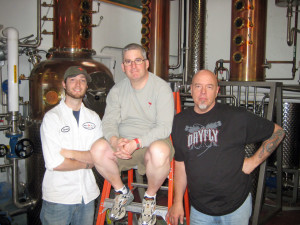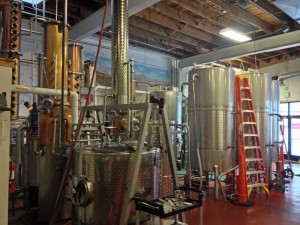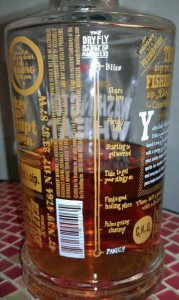Q&A With Dry Fly Distilling
An Interview with Dry Fly Co-Distiller Kent Fleischmann
By Richard Thomas

(Credit: Dry Fly Distilling)
Distilling and whiskey-making has spread all around the United States in recent years, sometimes to surprising locations. One region where the craft boom has gone that should surprise no one is the Pacific Northwest, where craft beer-making got a foothold as far back as the 1970s.
An increasingly familiar sight out of the Pacific Northwest craft distillery scene is the wheat whiskey from Spokane, Washingon’s Dry Fly Distilling. I’ve seen it with my own eyes in several shops in Kentucky, Tennessee, Georgia and Washington, DC, and know it’s also available through some Europe’s online retailers as well. I was fortunate to get a few words from Dry Fly co-distiller Kent Fleishman about the things his distillery has done, and where it is going in the near future.
RT: So tell me about the experience of starting up a distillery out in Washington state, so far from the traditional distilling grounds of the country.
KF: Yeah, that was a tough one. Washington State had nothing in place to handle craft distilling back in 2007. We had to find help. Our local Senator, Chris Marr, was interested in our project, but reminded us the upcoming session in Olympia was going to be fairly short, and although interesting, the plan to “level the playing field” like breweries or wineries who could taste and sell from their premises, [might] not happen [on] the first go, especially with liquor in a Control State. [You may know] that Washington was the first to go public.
So basically we needed to create the Craft Distillers Bill and fast. There was a lot of buzz around this cool new distillery starting and many eyes and ears were on us. One day out of the blue a guy called us who was a lobbyist at the State Capital and wanted to help. He reminded us that the project is not about being equal, but about agriculture. State agriculture, farmers and their families. The concept worked and he was right, the bill was introduced and passed the first time out. So unlike some other states, the Dry Fly Craft Distillers bill requires a minimum of 51 percent usage of farm grown products to get the benefits of being a craft distiller which include sampling and selling to customers. We were the first distillery to operate legally in the state, post-prohibition, and the first to sell liquor outside of a State store.

(Credit: Dry Fly Distilling)
RT: Something Dry Fly does that I don’t see virtually anywhere else is running its own in-house consultation program, basically a workshop on how to run your own distillery. How has that been working out for you?
KF: It was only weeks after we opened the phone started ringing, voices on the other end claiming things like “You stole my dream” and “hey can we come hang out for a week and learn what you know?” Well we knew there was an interest and we knew there was a value to our project in teaching others. We were a true, and still rare, grain to glass distillery and had already claimed Best Vodka, Best in Show and Double Gold at San Francisco Spirit Competition in 2009. We felt it was time to start helping others.
Some ask “aren’t you just creating competition?” and although true, we were more concerned with teaching the right way to be a craft distiller. So many before us actually don’t even make any alcohol, nor do you need to. You can buy neutral grain spirits for vodka and gin and even buy whiskey well-aged and ready for bottling. We felt it was important to try to keep the level of craft distilling high and most of all honest. There are many schools offering to help, not like this one.
Unlike the others where you can stand in a crowd of dozens and hope to learn something, our is private, one-on-one completely hands-on. You work here for a week, you work hard. But you leave here with the knowledge of doing things right. Many successful [people] have. Just check out our website and see the alumni.
Also we are booked out till mid-2015 as we only do about ten week-long classes per year.
RT: One of the more interesting things coming out of craft distilling in America is the use of oddball grains, and you had a limited edition release using triticale, the rye-wheat hybrid. What inspired you to do that? How did you even learn about triticale in the first place?
KF: We were hoping to create a rye. But we quickly learned rye is such a noxious weed and eastern Washington has about a billion acres of wheat fields, no one would grow rye for us. We heard about triticale from our wheat farmer and liked what we read. We played with a few batches but it really wasn’t as good as we expected and almost gave up the project. Until we heard about an heirloom seed of triticale that was available and we gave it one last attempt… and boy are we glad we did. This turned out to be one of our best whiskeys and really impresses people when they try it. Although our distilling principals are traditional, Dry Fly does not make traditional liquor.
RT: When Dry Fly comes up, about half the time someone mentions the tongue-in-cheek meter you have inked on the back of your bottles. How did that come into being?

(Credit: Jake Emen)
KF: That one’s on our wheat whiskey bottle. We once had a paper label real nice and all, but decided it was way to “normal.” We figured we needed to go a bit more “novelty.” Plus the front tells, no actually it kind of yells “hey this is wheat whiskey and it’s from Washington!” The back was a fun idea of “trout-isms,” and the Gage of Happiness to which your question refers was an idea of our designer, a small shop in North Carolina who added that at the final submission to us. We loved it and we kept it. That bottle did well at the National Addy Awards for our designer. And kind of like a cereal box, its something to read while having your morning whiskey!
RT: Compared to a lot of other micro-distilleries, Dry Fly is in pretty widespread distribution inside North America. Yet you are also based on two 450-liter CARL stills. Are you thinking of expanding down the road?
KF: You’d be amazed at what we can accomplish with those great stills. But in all fairness to your question, we are planning our next phase which includes a new still and support equipment to start making a lot more whiskey. A lot more.
RT: What kind of new whiskey might we expect from Dry Fly in the near future? Any new experiments on the horizon?
KF: Yep. We are looking at two types of Irish whiskey coming out next year. We have some much older single malts coming, some now 7 years old, and we have some top secret stuff too.




